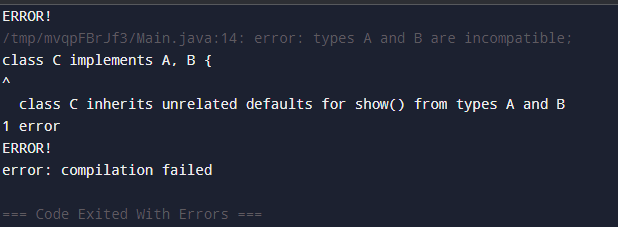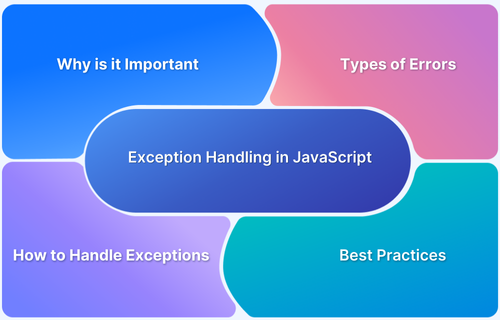Java supports object-oriented programming. One of its core features is inheritance, which allows one class to use the properties of another.
Overview
What is Diamond Problem in Java?
The Diamond Problem in Java arises when a class inherits from two interfaces with a common ancestor that defines the same default method, causing ambiguity. Java avoids this in classes by disallowing multiple inheritance but requires the class to resolve conflicts when using interfaces.
How to Solve the Diamond Problem in Java:
- Always override the conflicting default method in the implementing class to eliminate ambiguity.
- Use InterfaceName.super.method() to explicitly call the desired interface’s method.
- Avoid default methods in interfaces if not necessary; prefer abstract methods.
- Design interfaces with clear, distinct responsibilities to prevent method overlap.
- Java disallows multiple class inheritance, avoiding the diamond problem entirely at the class level.
This article explores how Java handles complexities like the diamond problem through strict design choices and interface-based resolution.
What is the Diamond Problem in Java?
The diamond problem occurs when a class inherits from two interfaces or classes that share a common ancestor, leading to ambiguity if both define the same method.
Java prevents this with classes by disallowing multiple inheritance but allows it with interfaces, requiring the implementing class to resolve any conflicts explicitly.
What is Multiple Inheritance in Java?
Multiple inheritance means a class inherits from more than one parent class. In many languages, this lets a class combine features from several sources. But in Java, this is not allowed with classes.
The reason ties back to the diamond problem. Java won’t know which one to inherit if two parent classes have methods with the same name.
To prevent confusion, Java blocks multiple class inheritance. Instead, it allows various inheritance only through interfaces, where the implementing class must resolve conflicts.
Also Read: Assert in Java
Types of Inheritance in Java
Java supports several inheritance types, each with its structure. These include single, multilevel, hierarchical, and hybrid inheritance.
Only single inheritance is allowed with classes, while interfaces enable other types without causing ambiguity.
- Single Inheritance: One class inherits from another, forming a straightforward parent-child relationship. Keeps the structure simple and easy to manage.
- Multilevel Inheritance: A class inherits from a parent, which itself inherits from another. This creates a chain, promoting step-by-step code reuse.
- Hierarchical Inheritance: Multiple classes inherit from the same superclass, sharing common functionality without conflict.
- Multiple Inheritance: A class inherits from various sources. Java supports this through interfaces to avoid ambiguity and the diamond problem.
- Hybrid Inheritance: Combines two or more types of inheritance (e.g., multilevel + hierarchical). Java allows it using interfaces to maintain flexibility and clarity.
Learn More: Java Debugging Tools and Techniques
Understanding Diamond Problem in Java
The diamond problem happens when a class inherits two interfaces that contain the same default method.
This creates a method conflict, and Java doesn’t allow it unless it is resolved.
interface A {
default void show() {
System.out.println("A");
}
}
interface B {
default void show() {
System.out.println("B");
}
}
class C implements A, B {
// No override here
public static void main(String[] args) {
C obj = new C();
obj.show();
}
}Output
Java doesn’t know whether to use A’s or B’s version of show(). Without a clear override, it refuses to compile.
It is implemented like this:
public class Main {
interface A {
default void show() {
System.out.println("A");
}
}
interface B {
default void show() {
System.out.println("B");
}
}
static class C implements A, B {
public void show() {
A.super.show(); // Or B.super.show()
}
}
public static void main(String[] args) {
C obj = new C();
obj.show();
}
}Now, the output will be
Read More: Exception Handling in JavaScript
How Java Handles the Diamond Problem
Java prevents the diamond problem using the following rules:
No Multiple Inheritance with Classes
A class cannot extend more than one class. This removes method ambiguity at the compiler level.
class A {}
class B {}
class C extends A, B {} //This is Not allowed
Multiple Inheritance with Interfaces Only
Java allows a class to implement multiple interfaces. This is safe because interfaces do not carry state.
interface A {}
interface B {}
class C implements A, B {} //This is Allowed
Conflict Detection at Compile-Time
If two interfaces have the same default method, the compiler forces the implementing class to override it.
interface A {
default void show() { System.out.println("A"); }
}
interface B {
default void show() { System.out.println("B"); }
}
class C implements A, B {
// Must override show() or compilation fails
public void show() {
A.super.show();
}
}Explicit Method Resolution Using InterfaceName.super.method()
The class must resolve the conflict by specifying which interface’s method to use.
Solving the Diamond Problem in Java
Java handles the diamond problem by design, but developers must follow clear practices when working with interfaces.
Learn More: Top 9 JavaScript Testing Frameworks
1. Override the Conflicting Method
When two interfaces have the same default method, override it in the implementing class. This removes ambiguity.
interface A {
default void greet() { System.out.println("Hello from A"); }
}
interface B {
default void greet() { System.out.println("Hello from B"); }
}
class Main implements A, B {
public void greet() {
A.super.greet(); // Resolving the conflict
}
public static void main(String[] args) {
Main obj = new Main();
obj.greet(); // Output: Hello from A
}
}2. Use Abstract Methods in Interfaces
Avoid default methods if possible. Let classes define their versions to stay safe from method conflicts.
3. Design Interfaces for Clarity
If two interfaces must have the same method, ensure they serve the same purpose. That reduces confusion for implementers.
Best Practices to Avoid the Diamond Problem in Java
To prevent issues related to the diamond problem, developers can follow these simple best practices:
- Avoid Overlapping Default Methods: Ensure default interface methods have unique names or clearly defined responsibilities to prevent conflicts.
- Always Override Conflicting Defaults: When two interfaces provide the same default method, override it in the implementing class to eliminate ambiguity.
- Prefer Composition Over Inheritance: Use composition to build modular, testable components instead of relying on complex inheritance structures.
- Keep Interfaces Focused: Design interfaces with a single responsibility to maintain clarity and minimize the risk of method conflicts.
- Use Testing Tools like BrowserStack Automate: Test Java applications across real devices and browsers using BrowserStack Automate to validate interface-driven behavior and ensure cross-platform consistency.
Conclusion
Java’s design avoids the diamond problem by restricting multiple inheritance to interfaces. While this removes major conflicts, method-level ambiguity can still occur when default methods collide.
Developers can write clean, conflict-free code and confidently deliver stable applications by following good interface design practices and using reliable testing tools like BrowserStack.








